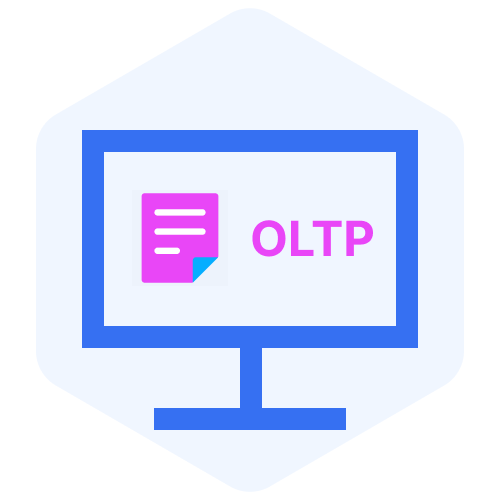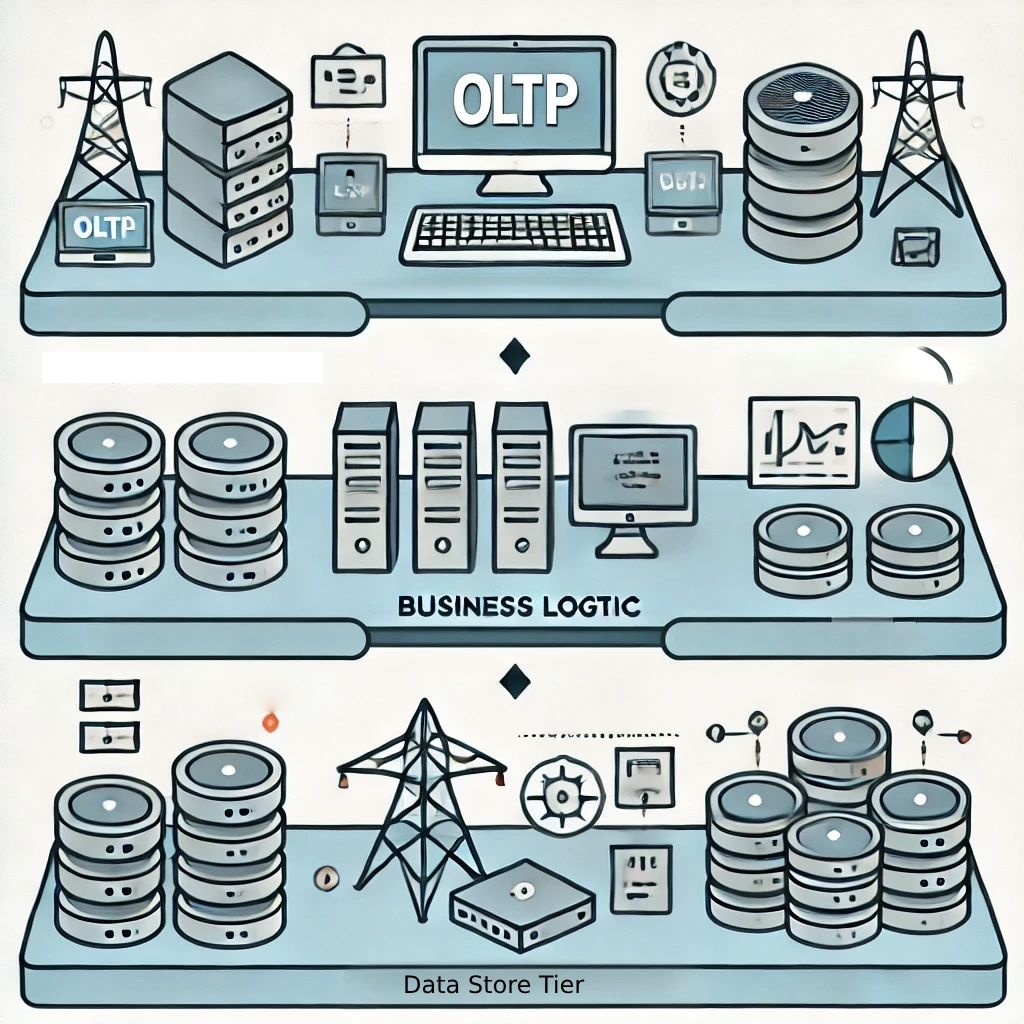What is Online Transactional Processing (OLTP)?

What is Online Transactional Processing (OLTP)?
Introduction
From booking a last-minute flight to swiping your credit card at the coffee shop, the seamless transactions that punctuate our daily lives are powered by Online Transaction Processing, or OLTP, systems. These systems are the backbone of modern commerce, supporting everything from financial operations to customer service interactions. They ensure that countless transactions are executed accurately and swiftly, often in the blink of an eye, to meet the demands of businesses and consumers alike.
This article explores the key characteristics, architecture, and significance of data integrity in OLTP systems. It also covers the types of databases used, performance optimization techniques, and common challenges and compares OLTP with Online Analytical Processing (OLAP). We'll also discuss real-world applications and future trends of OLTP systems, providing a comprehensive understanding of OLTP in today’s data-driven world.
Key Takeaways
Online Transactional Processing (OLTP) systems are essential for managing high volumes of real-time transactions, ensuring efficiency, accuracy, and data integrity across various business sectors.
Key characteristics of OLTP include adherence to ACID properties to maintain data integrity, high transaction processing speed, and a three-tier architecture that supports efficient transaction management.
Common challenges of OLTP systems include concurrency issues, deadlocks, and performance bottlenecks, which can be mitigated through effective system design and optimization techniques.
Understanding Online Transactional Processing (OLTP)
 An illustration depicting online transactional processing (OLTP) systems in action..jpeg
An illustration depicting online transactional processing (OLTP) systems in action..jpeg
Online Transaction Processing (OLTP) is a crucial data processing technique designed to handle a high volume of essential database transactions in real-time, such as processing orders, updating inventory, and managing customer accounts. OLTP systems are integral to businesses that require immediate data capture, storage, and processing to ensure smooth operations. They provide swift updates and modifications across various applications, from web to mobile platforms, facilitating a seamless user experience. For example, when a customer places an order online, the OLTP system promptly updates the inventory, processes the payment, and issues an order confirmation. This capability is vital for sectors like online banking, retail, and e-commerce, where rapid transaction processing is critical.
Unlike Online Analytical Processing (OLAP) systems, which are geared toward complex queries and data analysis, OLTP systems focus on optimizing the speed and efficiency of short, individual transactions. They employ various optimization techniques to quickly access and manage data, thereby improving responsiveness and allowing for the simultaneous handling of numerous transactions. This is essential for maintaining up-to-date information and supporting the day-to-day operations that underpin smooth business processes.
Architecture of OLTP Systems
 Visualization of OLTP System Architecture
Visualization of OLTP System Architecture
OLTP systems are structured around a three-tier architecture to support efficient transaction management and ensure optimal performance. This architecture includes the presentation tier, business logic tier, and data store tier, each serving a distinct role in processing transactions.
Presentation Tier: This is the user interface layer where transactions are initiated. It interacts directly with end-users, allowing them to input data and initiate transactions. For example, when a customer places an order on an e-commerce website, the presentation tier captures the order details and sends them to the business logic tier for processing.
Business Logic Tier: This tier is responsible for validating and processing transactions, ensuring that each transaction is executed correctly. It performs critical functions such as checking stock levels, calculating total costs, processing payments, and managing concurrency issues through mechanisms like locking and transaction isolation to ensure data integrity. Once a transaction is validated, this tier communicates with the data store tier to update the database.
Data Store Tier: Here, all transactional data is securely stored and managed. This tier is designed to handle high volumes of data writes and updates to ensure swift processing of transactions. It typically utilizes relational databases such as Oracle, MySQL, or Microsoft SQL Server, which are optimized for quick data retrieval and efficient transaction handling. This tier also implements security measures such as data encryption and secure data transmission to protect sensitive transaction information.
Enhancements for Scalability and Performance:
Each tier can be independently scaled to accommodate increased demand. For example, deploying multiple instances of the business logic tier can help manage more transactions simultaneously.
The use of in-memory databases or additional caching mechanisms can significantly reduce response times and improve system performance.
Security and Redundancy:
Comprehensive security protocols are crucial at each tier to safeguard transactional data, including robust authentication, authorization, and encryption methods.
Redundancy strategies and regular data backups are employed to ensure data availability and support disaster recovery efforts.
Importance of Data Integrity in OLTP
 An infographic highlighting the importance of data integrity in OLTP systems..jpeg
An infographic highlighting the importance of data integrity in OLTP systems..jpeg
Maintaining data integrity in OLTP systems is important for ensuring accuracy and reliability. This is achieved by adhering to the foundational ACID properties: Atomicity, Consistency, Isolation, and Durability.
Atomicity ensures that an entire transaction either succeeds or fails as a single unit, preventing partial updates.
Consistency guarantees that transactions always leave the database in a valid state, adhering to all validation rules and constraints.
Durability ensures that committed transactions remain so even during system failures.
Isolation levels in OLTP systems balance performance and data accuracy by managing how transactions are isolated from one another, preventing data errors during simultaneous user access.
OLTP systems often use a fully normalized database schema to ensure data consistency and prevent data duplication.
Types of Databases Used in OLTP
Online Transaction Processing (OLTP) systems typically use databases that are optimized for handling a high volume of transactional tasks. These databases are structured to ensure fast, reliable, and secure data access and updates. Here are the primary types of databases commonly used in OLTP systems:
Relational Databases (RDBMS)
Relational databases manage data according to a relational model, where data is stored in tables with predefined relationships between them. Popular relational databases used in OLTP systems include Oracle Database, MySQL, Microsoft SQL Server, and PostgreSQL.
Such systems provide strong data integrity, support complex transactions with ACID (Atomicity, Consistency, Isolation, Durability) compliance, and allow for sophisticated query capabilities using SQL (Structured Query Language).
In-Memory Databases
In-memory databases store data directly in the system’s main memory rather than on disk-based storage, which greatly speeds up data access times. SAP HANA and Redis are notable examples of in-memory databases used in OLTP environments.
Their primary advantage is the reduction in data access latency, providing faster response times for transaction processing and increasing throughput.
NoSQL Databases
NoSQL databases are designed for wide-scale, distributed data management. They often allow for flexible schema design, making them adaptable to the type and nature of the data being handled. Cassandra and MongoDB are widely used NoSQL databases in environments where scalability and high availability are critical, even though they may sacrifice some ACID properties.
They handle large volumes of data with high write loads and can scale horizontally, which is beneficial for applications requiring massive parallel processing.
NewSQL Databases
NewSQL databases attempt to combine the high scalability of NoSQL systems with the strong consistency and ACID compliance of traditional relational databases. Google Spanner and CockroachDB are examples of NewSQL databases that are becoming popular in OLTP systems.
These databases provide the scalability of NoSQL systems while ensuring transaction integrity and SQL compatibility, making them suitable for modern transactional applications that require robustness at scale.
Key Considerations for Choosing an OLTP Databases
When selecting a database for an OLTP system, considerations include:
Transaction Volume: How many transactions the system needs to handle simultaneously.
Data Integrity and Consistency: Ensuring that the data remains accurate and reliable across all transactions.
Performance and Latency: The system's ability to perform under load with minimal delay.
Scalability: Whether the system can grow with the business needs without performance degradation.
Performance Optimization for OLTP Systems
Optimizing OLTP system performance is crucial for efficient transaction processing. Effective indexing significantly enhances query performance by accelerating query processing. This involves identifying commonly used queries and creating indexes on appropriate columns.
Database sharding and caching are techniques that further optimize OLTP performance. Sharding distributes data across multiple servers for scalable data management, while vertical scaling increases hardware capabilities. Caching small read-only tables can significantly reduce query latency.
Addressing performance bottlenecks is essential for optimal OLTP system performance. Disk access speed is a significant bottleneck, being slower than memory and CPU. Utilizing in-memory data fabric can enhance real-time data processing by storing data directly in RAM, significantly speeding up access.
Common Challenges in OLTP Systems
OLTP systems face challenges such as concurrency issues, deadlocks, and performance bottlenecks. Concurrency controls enable multiple users to access and modify data simultaneously, maintaining system performance. However, inefficient concurrency algorithms and locking mechanisms can cause performance problems.
Deadlocks occur when transactions are waiting for each other, resulting in a standstill. Preventing deadlocks can be achieved through methods like transaction timeout and prioritization.
Performance bottlenecks often stem from inefficient locking mechanisms and long wait times for resources, which can be mitigated through careful system design and optimization.
OLTP vs OLAP
Online Transaction Processing (OLTP) and Online Analytical Processing (OLAP) are two pivotal systems used in data handling and database management. While both play crucial roles in business operations, they serve distinct purposes and are optimized for different tasks.
OLTP: Focused on Transaction Management
OLTP systems are designed to manage and process high volumes of short transactions quickly. These systems are transaction-oriented and are used primarily for data entry and retrieval. They are optimized for efficiency, handling simple queries that read and write small amounts of data. OLTP databases are characterized by their ability to maintain data integrity and quick response times, supporting real-time business operations. Common uses of OLTP include managing sales transactions, customer relationships, and financial records.
OLAP: Focused on Complex Queries
On the other hand, OLAP systems are designed to perform complex queries and are optimized for data analysis. These systems manage large volumes of data, supporting decisions by providing insights and recognizing patterns over time. OLAP databases are structured to handle large and complex queries that aggregate and analyze vast amounts of data, such as those needed for financial forecasting, trend analysis, and strategic planning.
Key Differences
The primary distinction between OLTP and OLAP lies in their data processing capabilities. OLTP systems are optimized for operational tasks that require rapid, atomic transactions. In contrast, OLAP systems are designed for analytical tasks that require aggregation and analysis of historical data across dimensions. OLTP systems excel in speed and efficiency, processing many small transactions, while OLAP systems excel in processing complex queries to derive meaningful insights from large datasets.
Here is a table that summarizes the key differences between OLTP and OLAP for clearer understanding:
| Aspect | OLTP | OLAP |
|---|---|---|
| Primary Use | Transaction processing | Data analysis and reporting |
| Data Updates | Frequent and in real-time | Less frequent, batch updates |
| Query Complexity | Simple queries accessing few records | Complex queries accessing many records |
| Database Design | Highly normalized to reduce data redundancy | Highly denormalized to improve query performance |
| Focus | Speed of individual transactions | Speed of query processing and response |
| Examples | Order entry systems, retail sales | Financial reporting, business performance analysis |
Real-World Applications of OLTP
 An illustration of real-world applications of online transaction processing (OLTP) systems..jpeg
An illustration of real-world applications of online transaction processing (OLTP) systems..jpeg
OLTP systems manage real-time transactions across various industries, ensuring data integrity and quick processing. In the financial sector, OLTP systems power ATMs and other financial transaction systems, ensuring customer accounts are updated instantly. This capability is crucial for maintaining customer trust and operational efficiency.
E-commerce platforms also rely heavily on OLTP systems for order processing and inventory management. When a customer places an order, the OLTP system updates the inventory, processes the payment, and generates an order confirmation—all in real time.
Reservation systems in the travel and hospitality sectors use OLTP to manage bookings, payments, and service confirmations, ensuring customers receive timely and accurate information. In healthcare, OLTP systems efficiently manage patient data, providing quick access to medical records and ensuring data accuracy.
Summary
In summary, Online Transactional Processing (OLTP) is a vital technology that supports the seamless execution of everyday business operations. By handling high volumes of transactional data in real time and maintaining data integrity, OLTP systems ensure that businesses can operate efficiently and provide reliable services to their customers. Key characteristics such as high transaction volume, real-time processing, and adherence to ACID properties underscore the importance of OLTP in maintaining data accuracy and reliability.
As we look to the future, advancements in cloud technology, AI, LLMs, and data visualization tools promise to further enhance the capabilities of OLTP systems. These innovations will enable businesses to manage complex transactions and large volumes of data more effectively, driving operational efficiency and informed decision-making. The journey through the world of OLTP reveals its critical role in our digital interactions and its potential to shape the future of business operations.
Frequently Asked Questions
What is OLTP?
OLTP, or Online Transactional Processing, is a technology designed to efficiently handle and process a large number of real-time database transactions, facilitating essential operational tasks like order processing and inventory management. This system is crucial for organizations that require swift and reliable transaction handling.
How do OLTP systems ensure data integrity?
OLTP systems ensure data integrity by adhering to the ACID properties, which guarantee reliable transaction processing and maintain the database in a valid state. This structured approach is crucial for sustaining data accuracy and integrity.
What are the key characteristics of OLTP systems?
OLTP systems are characterized by high transaction volumes, real-time processing, and a strong emphasis on data integrity. They efficiently manage numerous small transactions, ensuring data consistency and reliability.
How do OLTP and OLAP differ?
OLTP is primarily concerned with transaction processing and operational tasks, emphasizing frequent updates, while OLAP is tailored for complex queries and data analysis, utilizing denormalized databases to enhance query speed. Therefore, OLTP and OLAP serve distinct purposes in data management, with OLTP focused on real-time transactions and OLAP geared towards analytical processing.
What are some real-world applications of OLTP?
OLTP is widely used in managing ATMs and financial transactions, processing orders and inventory in e-commerce, handling bookings and payments in travel systems, and efficiently managing patient data in healthcare. These applications highlight OLTP's critical role in facilitating day-to-day operations across various industries.
Further Resources
- Introduction
- Key Takeaways
- Understanding Online Transactional Processing (OLTP)
- Architecture of OLTP Systems
- Importance of Data Integrity in OLTP
- Types of Databases Used in OLTP
- Performance Optimization for OLTP Systems
- Common Challenges in OLTP Systems
- OLTP vs OLAP
- Real-World Applications of OLTP
- Summary
- Frequently Asked Questions
- Further Resources
Content
Start Free, Scale Easily
Try the fully-managed vector database built for your GenAI applications.
Try Zilliz Cloud for Free